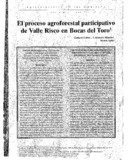| dc.contributor.author | Calvo, Gustavo | es_ES |
| dc.contributor.author | Méndez, V. Ernesto | es_ES |
| dc.contributor.author | Ortiz, Meivis | es_ES |
| dc.date.accessioned | 2015-03-19T21:25:59Z | |
| dc.date.available | 2015-03-19T21:25:59Z | |
| dc.date.issued | 1999 | |
| dc.identifier | 457781 | es_ES |
| dc.identifier.uri | https://repositorio.catie.ac.cr/handle/11554/6182 | |
| dc.description.abstract | Se describe la experiencia de organización participativa en torno a la agroforestería de una comunidad indígena Ngöbe dedicada a la agricultura en Panamá. Debido a los bajos precios del cacao (Theobroma cacao L) y a las pérdidas provocadas por la monilia (moniliophthora roreri [Cif & Par] Evans et al.) muchos productores han debido abandonar el cultivo y dedicarse a cortar madera en bosques y cacaotales para mantener a sus familias. A través de un convenio entre el Proyecto CATIE-GTZ y la Autoridad Nacional de Ambiente de Panamá (antes INRENARE) se implementó un proceso de rehabilitación de los cacaotales y establecimiento de sombra de laurel (cordia alliodora). Mediante la creación de la Asociación Agroforestal de Valle Risco (ASAFRI) se ha logrado establecer una buena organización comunal que guía y define el manejo de los recursos naturales en la comunidad. Se cuenta con una finca agroforestal, donde se prueban diferentes sistemas que luego se diseminan entre los asociados y con una “Casa Agroforestal” donde se ofrece capacitación en diferentes tópicos y se organiza el trabajo comunitario para la rehabilitación de los cacaotales abandonados. Así, en el Valle de Risco la comunidad está organizada en torno a la agroforestería y sirve como ejemplo para otras comunidades panameñas e incluso grupos de indígenas Cabécares y Bribris de Costa Rica.
The agroforestry experience with participatory organization of an indigenous agricultural Ngöbe community in Panamá is described. Due to low cocoa (Theobroma cacao L) prices and losses caused Monilia (moniliophthora roreri [Cif & Par] Evans et al.) disease many of the producers have had to abandon their cocoa and cut timber from forests and cocoa plantations in order to support their families. Through an agreement between the CATIE-GTZ agroforestry project and the National Authority on the Environment (formerly INRENARE) of Panamá, a process of rehabilitation of cocoa plantation has begun, using the establishment of laurel (Cordia alliodora) as a shade tree. Through the creation of Agroforestry Association of the Risco Valley (ASAFRI), a good community organization has been successfully established to guide and define the management of natural resources in the community using: a) an agroforestry farm where the different agroforestry systems are tried out and b) an “Agroforestry House” where a community programme to rehabilitate the abandoned cocoa plantations is being organised. Thus, in the Risco Valley the community is organised on the basis of agroforestry and is an example for the other Panamanian communities, as well as for indigenous Cabécares and Bribris of Costa Rica. | es_ES |
| dc.language.iso | es | es_ES |
| dc.publisher | CATIE, Turrialba (Costa Rica) | es_ES |
| dc.relation.ispartof | Agroforestería en las Américas (CATIE) Volumen 6, número 21 (1999), páginas 14-17 | |
| dc.subject | AGROFORESTERIA | es_ES |
| dc.subject | PARTICIPACION COMUNITARIA | es_ES |
| dc.subject | THEOBROMA CACAO | es_ES |
| dc.subject | CORDIA ALLIODORA | es_ES |
| dc.subject | GRUPOS ETNICOS | es_ES |
| dc.subject | PANAMA | es_ES |
| dc.title | El proceso agroforestal participativo de Valle Risco en Bocas del Toro | es_ES |
| dc.type | Artículo | es_ES |
| dc.journal.issueNumber | 21 | |


